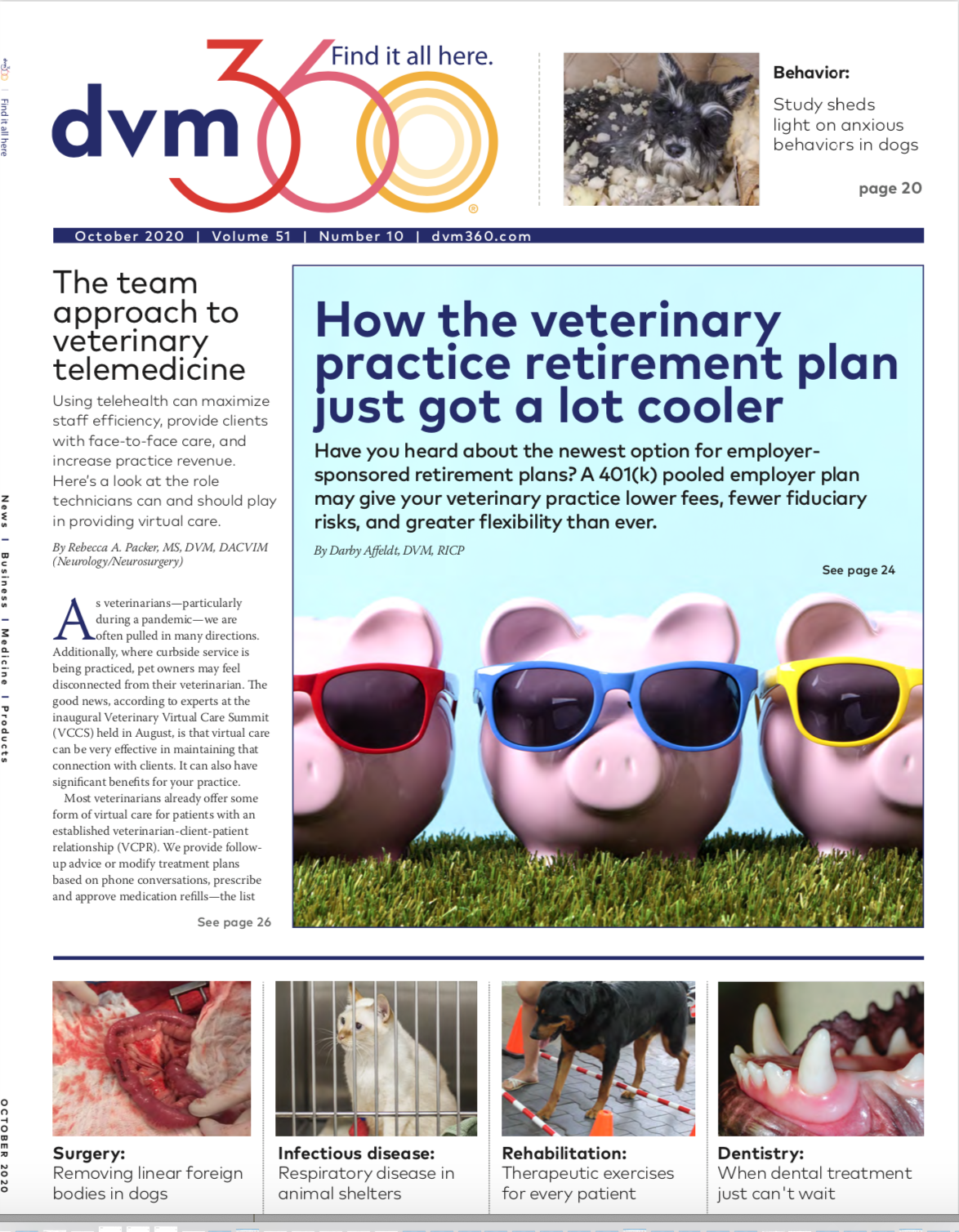Therapeutic exercises for every veterinary patient
Just like in people, proper rehabilitation in pets requires exercise, but you dont need to have lots of fancy equipment to make it happen. Heres what you need to know before devising a rehab program, plus some exercises that any practitioner can employ.
“Therapeutic exercises are the cornerstone of rehabilitation,” said Janice Huntingford, DVM, DACVSMR, CVA, CVPP, CCRT, CAVCA, to begin her lecture at the 2018 Atlantic Coast Veterinary Conference in Atlantic City, New Jersey. “It's not lasers, and it's not underwater treadmills.”
Why exercise?
There are myriad reasons why a veterinarian might create an exercise regimen for a patient, including to promote weight loss; improve range of motion; improve muscle strength, flexibility, balance, gait and proprioception; enhance endurance and performance; decrease pain; and improve healing.
The most important thing when developing an exercise plan, Dr. Huntingford advised, is to keep your patient top of mind, including its age, injury, diagnosis, available resources and limitations-with limitations being the most crucial. The client is an important consideration, too.
“I always think about what kind of client I have, because we are doing exercises not just in the hospital,” she said. “I send all of my patients home with a recommended exercise program.” Because at-home exercise is vital to the success of a patient's rehabilitation, veterinarians must be able to tailor exercises accordingly. “The regimen that's devised must meet the capabilities of both pet and owner,” she said.
Before you prescribe an exercise regimen
Before developing any type of exercise program, you must first understand the basics of exercise physiology. Type muscle 1 muscle fibers (slow twitch, oxidative, stabilizers) promote endurance, whereas type 2 fibers (fast twitch, glycolytic, mobilizers) are responsible for strength.
Understanding basic physiology is also necessary to recognize how the injury or immobilization of a muscle group will impact a patient. For example, a dog in a cast or splint will lose 50% of its muscle strength in just seven days, and geriatric sarcopenia causes atrophy of type 2 fibers. In addition, the veterinarian must be familiar with the three types of exercises and how they work the muscles:
- Isometric: A contraction in which the joint angle and muscle length remain static, such as during a plank hold
- Concentric: A contraction that shortens a muscle, such as the lifting motion of a bicep curl
- Eccentric: A contraction that lengthens a muscle, such as extending or lowering your arm in a bicep curl
Principles of an exercise program
Every patient is different, so exercise programs must be individualized. Dr. Huntingford advised keeping in mind the following nine principles when designing and executing an exercise regimen for your patients.
- Consider any underlying pathology that may affect the patient's ability to exercise.
- Consider the patient's psychological state and willingness to perform exercises.
- Consider the experience of the client.
- Set short- and long-term goals.
- Evaluate the patient at every visit.
- Ensure proper body mechanics for both therapist and patient.
- Use assistive devices if needed.
- Watch for signs of fatigue.
- Finish on a positive note.
For the vast majority of her patients, Dr. Huntingford focuses on four main components of an exercise program: balance and proprioception, core strengthening, endurance and flexibility. “Then, of course, you should also add in exercises that target the area of injury or disability (e.g. hindlimb, forelimb),” she said. Finally, for canine athletes, such as working dogs, you may choose to add in exercises that enhance strength and speed.
To help design an exercise program that best fits the needs and capabilities of a particular patient, Dr. Huntingford recommended considering these parameters:
- Frequency (how many times per day or week)
- Speed/intensity
- Duration of work (number of reps)
- Environment (terrain, footing, substrate)
- Impact (high, low or no impact)
“My rule of thumb,” she said, “is that you can increase activity by 10% to 15% per week if the patient is doing well.”
Exercises every practitioner can recommend
While water therapy is one of the key components of many exercise regimens-and is often what people associate most with veterinary rehabilitation-Dr. Huntingford explained that there are many exercises that can be done in the practice and at home that don't involve water at all.
Cavaletti cones. “This is without a doubt my favorite exercise,” Dr. Huntingford said. Cavaletti cones resemble a basic obstacle course and include a low bar set between two cones for support (Figure 1). This type of exercise is ideal for all geriatric patients, she said, and works to increase flexion and extension as well as to relieve pain. The height at which the bar is set for the exercise depends completely on the dog's breed and physical limitations.
Figure 1 (All photos courtesy of Dr. Huntingford.)
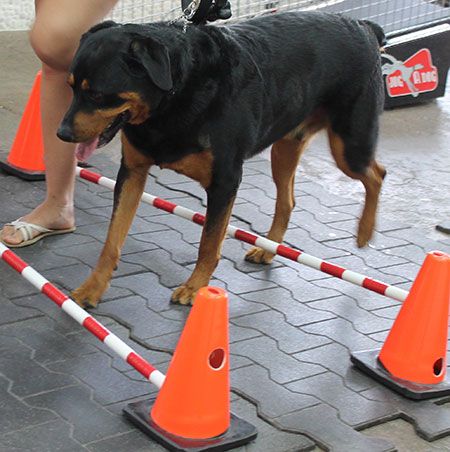
“Cavaletti bars for most patients should be placed no higher than the elbow and frequently much lower,” Dr. Huntingford said. “The shoulder would be if you want the dog to be jumping, but mostly it's going to be the height of the elbow. For the average geriatric dog-unless it is a Great Dane-the bar will only be 1 or 2 inches off the ground. For a dachshund, the bar will stay completely on the floor.”
Weaving. This exercise involves setting up Cavaletti cones (minus the bars) in a pattern that promotes weaving (Figure 2).
Figure 2
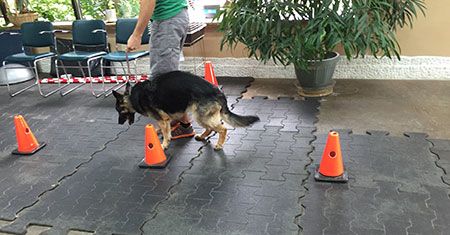
Backward walking. Guiding the patient to walk backward builds up hind leg strength and mobility. “This is something we need to be teaching all of our clients from the time their pets are little and then continue working on it, particularly for large-breed dogs,” Dr. Huntingford explained.
High fives. Encouraging the dog to use its front legs to give high fives is a simple yet effective exercise for animals with elbow ailments. Cats can get in on the fun, too (Figures 3A and 3B).
Figure 3A
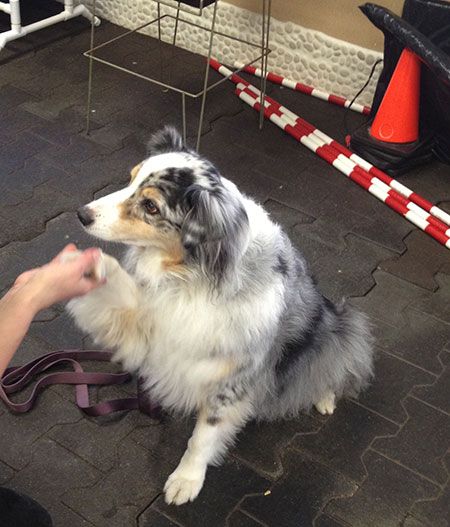
Figure 3B
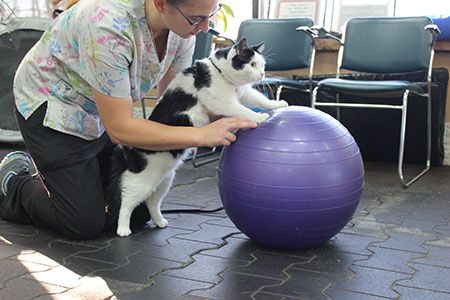
Uneven surfaces. This type of exercise can be done with a Bosu balance ball, or even cushions (Figure 4), to provide an uneven surface for the dog or cat that still allows the pet to keep all its legs in contact with a surface. These can be used for neurologic patients who are learning to stand again or for patients that need to increase balance or ease back into putting pressure on their front or hind legs.
Figure 4
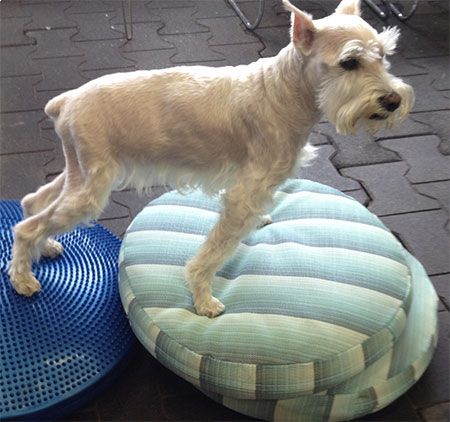
Hill walking. Have a patient walk on a slight incline to enhance strength, stability and endurance. Dr. Huntingford said that while incline treadmills are marketed specifically for dogs, a normal treadmill works just as well.
No matter the regimin you choose, remember to keep the patient in mind and get the client involved. There's an exercise (or some combination of exercises) that will work for every pet.
Amanda Carrozza is a freelance writer and editor in New Jersey.
